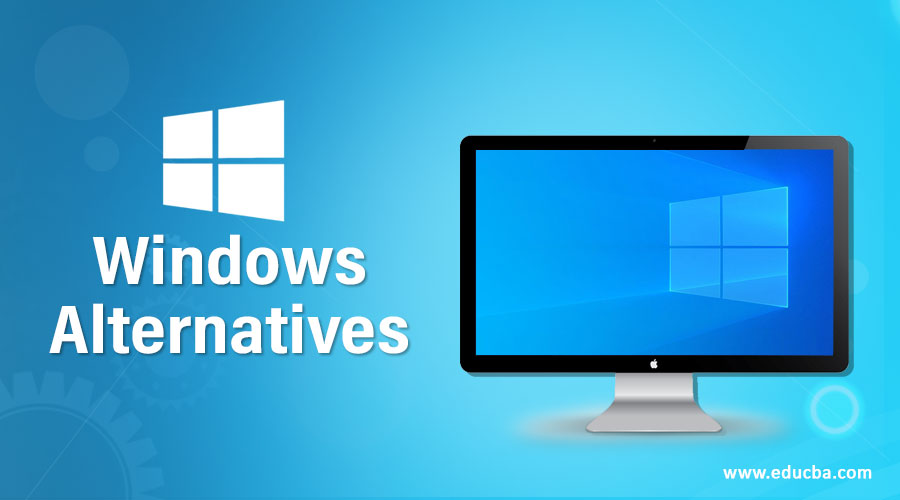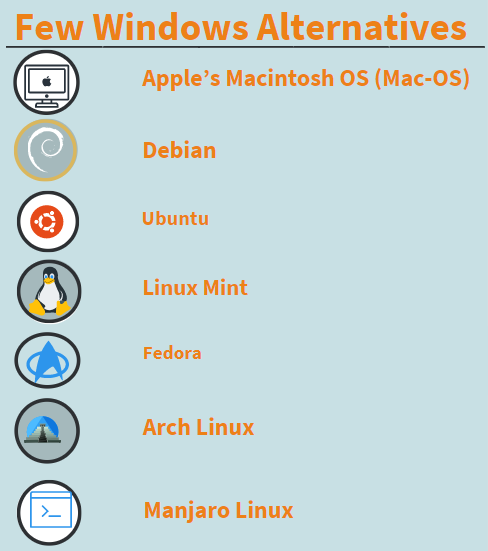Updated March 13, 2023

Introduction to Windows Alternatives
The first version of Windows was released by Microsoft in 1985. Its purpose was to provide a user-friendly graphical user interface for systems running on MS-DOS. Users using MS-DOS would have to manually type in commands to the computer with the help of a command prompt to interact with the computer. Windows made this entire process of typing in commands a click away. Soon Windows became the most popularly used operating system worldwide mainly due to its ease of use.
Well, what exactly is an operating system? To put it in simple terms, an operating system is nothing but the main software of your system that is responsible to sync’s up all the hardware, including your input and output devices (i.e., mouse, keyboard, hard-disk, display, etc.) and other third-party software’s on a computer. The operating system manages all the processes (tasks) running on your system and allocates resources accordingly to them.
As of today, the latest version- Windows 10, which was released on 15th July 2015, is the most popular operating system in the market. Windows 10 comes with new features such as Cortana integration, Microsoft Edge web browser, task view, Universal apps, etc. Windows 10 is estimated to be running on more than 700 million devices, including PC’s, Laptops, Tabs, mobiles, etc.
Few Windows Alternatives
Following are the main alternatives for windows which are as follows:
1. Apple’s Macintosh OS (Mac-OS)
Mac-OS was first introduced by the American corporation Apple Inc. in 1984. However, it wasn’t until 2001 when the company rolled out a major upgrade – Mac OS X, which gained immense popularity. Mac OS is one of the lists of top Windows alternatives because it comes with a major constraint that is it only runs on the computers manufactured by Apple. On the other hand, it comes with a number of built-in software’s like iMovie, Garage Band, Siri, etc., making it easier to perform numerous tasks. Mac OS provides better security as it is less susceptible to viruses and other malware as compared to Windows.
2. Debian
One of the oldest Linux distributions was found by Ian Murdok back in 1993 during his college days. Back then, Ian Murdok was dating Debra Lynn and hence named it “Deb + Ian” as a combination of their names. It is similar to Unix and is based on Linux kernel or FreeBSD kernel. It is also open-source, which means no cost is required for its installation. The installation comes with over 51000 packages, a package manager, and other utility packages making it possible for these inter-dependent packages to work together. It also provides interfaces for re-using these packages by other operating systems built on top of it like Ubuntu, Linux Mint, to name a few. As of today, the latest update of Debian – version 9.8 named “stretch” was released on 16th February 2019.
3. Ubuntu
Ubuntu was developed by Canonical Ltd under the leadership of its founder and CEO, Mark Shuttleworth. Ubuntu is named after the African philosophy of Ubuntu, which translates to “humanity to others” or “I am what I am because of who we all are”. The first stable release was Ubuntu 4.10 on 20th October 2004. It is also an open-source Linux distribution that is built on top of Debian and provides installation for desktops, Ubuntu servers, IoT devices such as Raspberry Pi and Cloud. The latest release is the Ubuntu 18.04 LTS “Bionic Beaver,” which was released on 26th April 2018 and will be supported till 2028.
Link for Download: https://www.ubuntu.com/desktop#download
4. Linux Mint
The best choice for an open-source alternative to windows is Linux Mint. It is undoubtedly one of the most popular distributions of Linux. Linux Mint was first released in 2006 and is based on Debian and Ubuntu OS. One could also use a windows PC to dual boot Linux Mint with the help of applications like Mint4Win.
The latest release was on 19th December 2018, Linux Mint 19 “Tessa”. This release is based on Ubuntu 18.04 and will be supported until April 2023.
Link for Download: https://linuxmint.com/download_all.php
5. Fedora
Yet another open-source distribution from Linux was developed by the Fedora Project and sponsored by Red Hat. Initial version Fedora Core 1 – “Yarrow” was released on 6th November 2003. It was based on Red Hat Linux 9 and came with Linux Kernel and GNOME desktop environment. Fedora is also one of the Windows alternatives as it comes with a wide range of software’s which include Firefox and LibreOffice. Other third-party software present in the software repository can be installed using the GNOME software or DNF package manager. The last release was on 30th October 2018. This new release came with a few notable features such as a new optional package repository called modular, Fedora Modularity, GNOME 3.30, etc.
Link for Download: https://getfedora.org/en/workstation/download/
6. Arch Linux
Aaron Griffin was the lead developer of the team which discovered Arch Linux. The first release came out on 11th March 2002. It is yet another one of Linux open-source distribution, which is lightweight and flexible. It was developed following the KISS principle, which stands for “Keep It Simple, Stupid”. Packman (acronym over “package manager”) is a package manager which was written for Arch Linux to install, remove, upgrade /downgrade software packages and features automatic dependency resolution. Arch User Repository (AUR) is a repository of software developed by other users of Arch Linux. Using the Arch Build System (ABS) and custom scripts, users develop packages compatible with Packman.
The current version of Arch Linux, which includes kernel version 4.20.13, was released on 1st March 2019.
Link for Download: https://www.archlinux.org/download/
7. Manjaro Linux
Manjaro Linux was found by Guillaume Benoit and Philip Müller and was initially released on 10th July 2011. Like most Linux distributions, this also falls under the freely available set of operating systems and is built on top of Arch Linux. It is a relatively new Linux distribution as compared to Debian, Ubuntu, Fedora and is the most user-friendly OS among them. Manjaro also provides excellent performance when compared to the other distributions of Linux. The latest version of Manjaro 18.0 goes by the code name Illyria, was released on 30th October 2018.
Link for Download: https://manjaro.org/download/
Recommended Articles
This has been a guide to Windows Alternatives. Here we have discuss the basic concept of windows and explained the top 7 Alternatives. You may also look at the following article to learn more :

